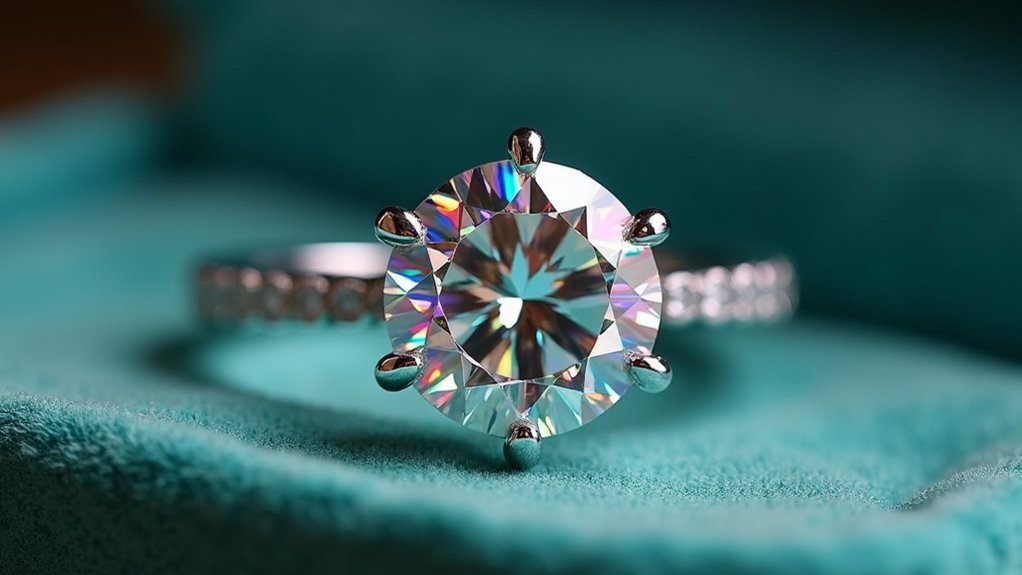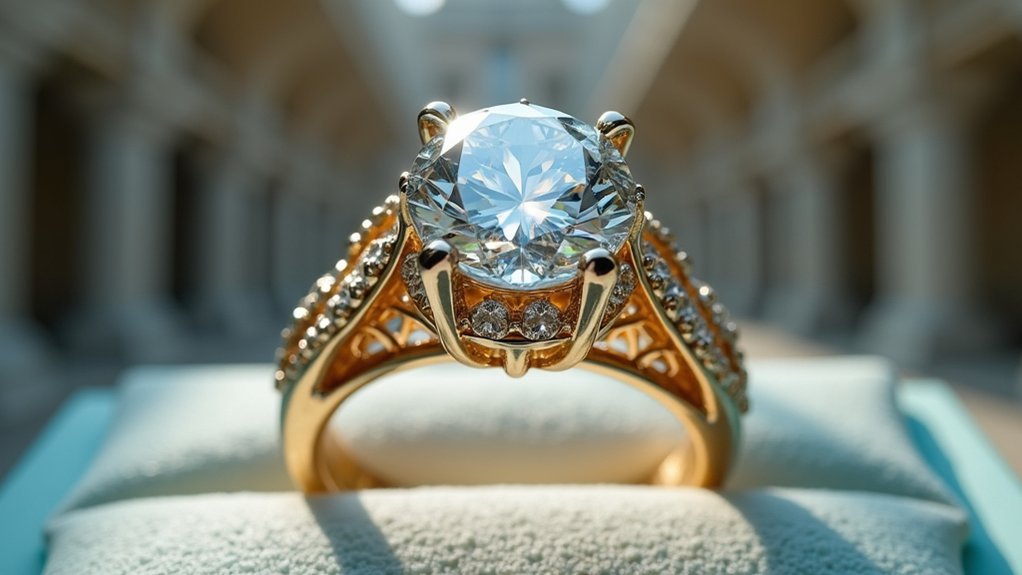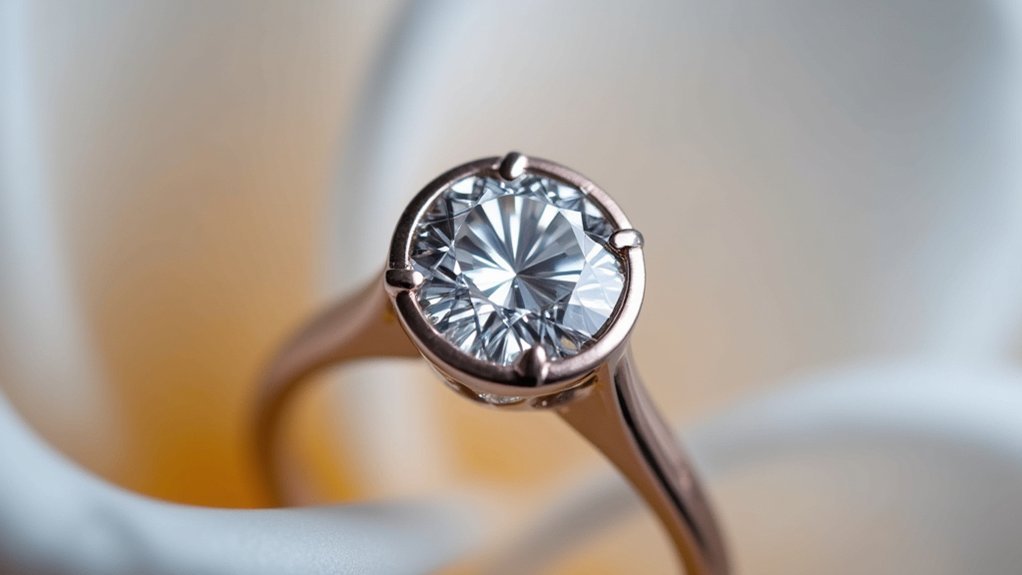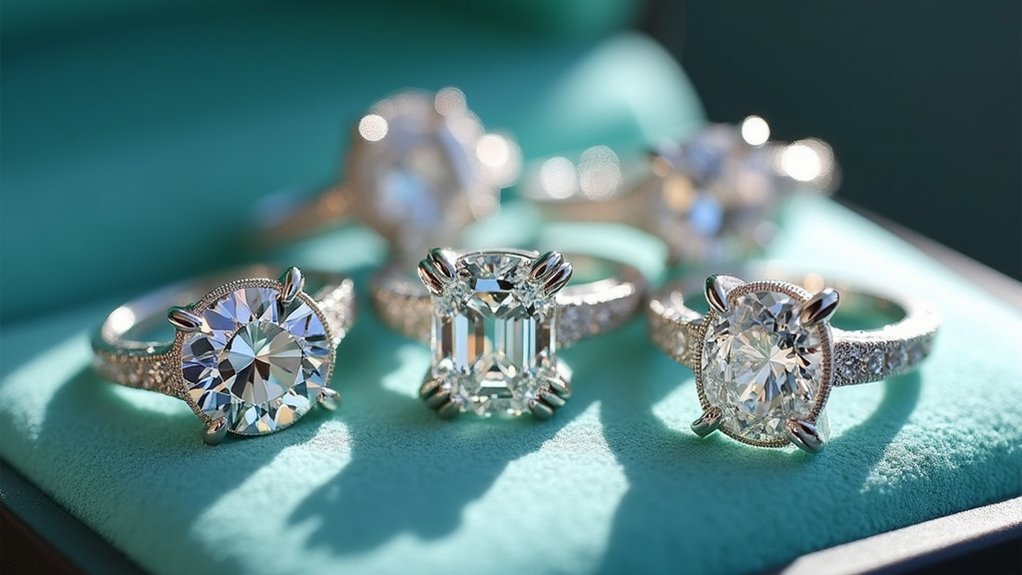You’ll find the six-prong Tiffany setting leads these premier techniques, lifting your diamond high for maximum brilliance since 1886. Pavé accents create a sparkling carpet effect along your band, while cathedral settings use graceful arches to elevate stones beautifully. Channel settings offer durability by securing diamonds between parallel walls, perfect for wedding bands. Bezel settings provide ultimate protection with metal rims surrounding your stone. Each technique offers unique advantages that we’ll explore further below.
The Classic Six-Prong Tiffany Setting Design

When Charles Lewis Tiffany introduced the six-prong setting in 1886, he revolutionized diamond ring design by creating a mount that lifts the stone high above the band.
This classic six-prong setting maximizes light entry, dramatically enhancing your diamond’s brilliance and fire. You’ll find this iconic design uses only the top 0.04% of gem-grade diamonds, guaranteeing exceptional clarity and sparkle.
The six prongs securely cradle your diamond while maintaining an elegant, minimalist appearance. You can choose from platinum or 18k yellow gold for the band, and customize it further with pavé diamond bands for added sophistication.
This setting represents the pinnacle of luxury and craftsmanship, embodying timeless elegance that’s made it the most recognizable engagement ring style worldwide.
Pavé Diamond Accents for Enhanced Brilliance
While the classic Tiffany setting showcases your center diamond beautifully, pavé diamond accents take brilliance to the next level by creating a continuous carpet of sparkle along your ring’s band.
This setting technique involves placing small diamonds closely together with minimal metal visibility, producing enhanced brilliance that amplifies your center stone’s visual impact.
The French term “pavé” means “paved,” perfectly describing how your ring appears diamond-encrusted. Tiny metal beads secure each stone while allowing maximum light entry, maintaining the seamless appearance that makes pavé so enchanting.
You’ll find pavé versatility in multiple applications:
- Halo design integration for increased sparkle
- Three-stone designs with accent enhancement
- Band coverage creating luxurious pathways
This technique transforms your overall design into a more sophisticated, eye-catching piece that maximizes brilliance.
Cathedral Setting Architecture for Elevated Diamonds

Beyond the sparkling pavé technique, cathedral setting architecture elevates your diamond through graceful arches that rise dramatically above the band. This elevation creates striking visibility for your center stone while maximizing brilliance through enhanced light entry.
The arches provide both security and delicate aesthetics, ensuring your diamond remains protected without sacrificing elegance.
You’ll find cathedral settings accommodate various diamond shapes, from round to princess cuts, making them perfect for custom designs. The sturdy band construction offers reliable security while maintaining refined appeal.
You can enhance your engagement ring further by pairing cathedral architecture with pavé accents or side stones, amplifying the overall glamour and visual impact of your ring design.
Channel Setting Techniques for Wedding Band Integration
Channel setting techniques create a continuous stream of diamonds by securing stones between two parallel metal walls, offering you exceptional durability for everyday wear.
This robust and secure method perfectly complements diamond rings by minimizing gaps between stones while maximizing light reflection. You’ll achieve a modern look that’s particularly stunning for wedding bands, as the seamless design creates extra sparkle without overwhelming your engagement ring.
When integrating channel-set wedding bands with your Tiffany engagement ring, focus on these essential elements:
- Band proportions – Guarantee matching widths and heights for visual harmony
- Stone alignment – Align diamonds to create uninterrupted light flow
- Metal consistency – Match metal types and finishes between rings
The channel setting securely holds multiple smaller diamonds within protective metal walls, making it ideal for couples seeking sophisticated, low-maintenance elegance.
Bezel Setting Applications for Maximum Diamond Protection

Since bezel settings surround your diamond with a protective metal rim, you’ll enjoy unmatched security without sacrificing style. This modern aesthetic delivers superior diamond protection against chips and scratches while perfectly suiting active lifestyles.
| Advantage | Benefit |
|---|---|
| Enhanced visual size | Metal rim makes diamond appear larger |
| Customized designs | Accommodates various shapes and styles |
| Superior durability | Minimizes loosening over time |
| Secure protection | Ideal for daily wear activities |
You’ll appreciate how bezel settings enhance your diamond’s visual size through the metal encasement’s attention-drawing effect. These customized designs offer exceptional durability compared to traditional prong settings. However, consider that the metal rim limits light entering your diamond, potentially reducing brilliance. Despite this trade-off, bezel settings remain excellent choices for maximum protection.
Frequently Asked Questions
What Setting Makes a Diamond Sparkle Most?
You’ll maximize diamond sparkle with the prong setting, especially six-prong designs. They elevate your diamond above the band, allowing maximum light entry from all angles, which enhances brilliance and creates stunning sparkle.
What Is the Best Setting to Show off a Diamond?
You’ll find the Tiffany® Setting shows off diamonds best. Its six-prong design elevates your stone above the band, maximizing light entry from all angles and creating unmatched brilliance that highlights every facet beautifully.
What Setting Makes a Diamond Look Biggest?
You’ll make your diamond look biggest with a halo setting, which surrounds it with smaller stones. Cathedral settings also help by elevating the diamond, while tension settings create a floating illusion.
What Is the Difference Between Tiffany and Cathedral Setting?
You’ll notice Tiffany settings use six prongs to make diamonds “float” above the band, while cathedral settings feature architectural arches that elevate stones with structural height and ornate visual appeal.
In Summary
You’ve explored five exceptional Tiffany setting techniques that’ll transform your diamond ring into a timeless masterpiece. Whether you’re drawn to the classic six-prong’s elegance, pavé’s sparkling brilliance, cathedral’s architectural beauty, channel’s seamless integration, or bezel’s protective embrace, each technique offers unique advantages. Consider your lifestyle, aesthetic preferences, and diamond’s characteristics when making your choice. These proven setting methods guarantee you’ll create a stunning ring that’ll showcase your diamond’s beauty for generations to come.





Leave a Reply